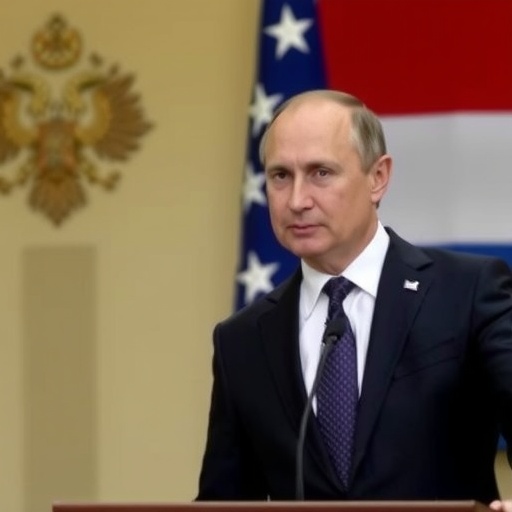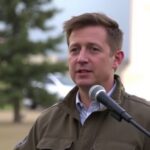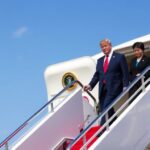Putin Envoy Signals Breakthrough: Russia, US, and Ukraine Nearing Diplomatic Solution to End War
In a stunning development amid the relentless grind of the Ukraine war, a senior envoy from Russian President Vladimir Putin has declared that Russia, the United States, and Ukraine are on the cusp of a diplomatic solution to halt the conflict. This optimistic assertion comes from Grigory Karasin, a high-ranking diplomat in the Russian Foreign Ministry, who spoke at a closed-door forum in Moscow on Wednesday. Despite the recent cancellation of a highly anticipated summit between U.S. President-elect Donald Trump and Putin, and the persistence of fierce military hostilities on the ground, Karasin’s words have ignited cautious hope among international observers.
- Karasin’s Revelation: Echoes of Putin’s Vision for Peace
- Trump-Putin Summit Fallout: A Setback or Strategic Pause?
- Battlefield Realities: Hostilities Persist Despite Diplomatic Whispers
- Global Echoes: How the World Views Russia’s Diplomatic Overture
- Navigating the Road Ahead: Hurdles and Horizons for Ukraine Peace
The envoy’s statement marks a potential turning point in the protracted US-Russia tensions over Ukraine, a war that has claimed tens of thousands of lives and reshaped global alliances since Russia’s full-scale invasion in February 2022. “We are closer than ever to a framework that addresses the core issues,” Karasin reportedly said, emphasizing backchannel negotiations involving all three parties. This comes as Ukrainian forces report repelling Russian advances in the Donbas region, while Moscow continues to mobilize resources for what it calls a “special military operation.”
Karasin’s Revelation: Echoes of Putin’s Vision for Peace
Grigory Karasin, a veteran of Russian diplomacy with decades of experience in Eurasian affairs, delivered his remarks during a session focused on post-conflict reconstruction. Known for his close ties to the Kremlin, Karasin has been instrumental in shaping Russia’s narrative on the Ukraine war. His claim of proximity to a diplomatic solution aligns directly with Putin’s longstanding calls for negotiations that respect Russia’s security concerns, including the demilitarization of Ukraine and recognition of annexed territories.
“The involvement of the US is key,” Karasin elaborated, according to sources familiar with the forum. “Washington’s role cannot be understated in bridging the gaps between Moscow and Kyiv.” This nod to US-Russia collaboration underscores a shift from the acrimonious rhetoric that dominated relations during the Biden administration. Putin himself has hinted at similar sentiments in recent interviews, stating in a December broadcast that “diplomatic avenues remain open if our partners show goodwill.”
To contextualize Karasin’s optimism, it’s worth recalling the war’s toll. According to the United Nations, over 10,000 civilians have been killed in Ukraine since the invasion began, with millions displaced. Economically, Russia faces sanctions that have crippled its energy exports to Europe, while Ukraine grapples with infrastructure devastation estimated at $500 billion by the World Bank. These stark realities amplify the urgency of any diplomatic solution, potentially averting further escalation.
Experts like Fiona Hill, a former U.S. National Security Council official, have noted that such statements from Russian envoys often serve dual purposes: signaling intent while testing international reactions. “Putin’s team is masterful at diplomacy by ambiguity,” Hill commented in a recent podcast. Yet, Karasin’s specificity—mentioning trilateral talks—suggests more substance than posturing.
Trump-Putin Summit Fallout: A Setback or Strategic Pause?
The shadow of the cancelled Trump-Putin summit looms large over Karasin’s announcement. Initially floated as a post-inauguration meeting in early 2025, the summit was envisioned as a reset for US-Russia ties, with Ukraine as the centerpiece. Trump, who has repeatedly criticized the war’s prolongation, promised during his campaign to end the conflict “in 24 hours” through direct negotiations with Putin.
However, the summit was abruptly called off last week, citing “scheduling conflicts and logistical hurdles,” according to a Kremlin spokesperson. Insiders reveal deeper issues: disagreements over the agenda, particularly Ukraine’s NATO aspirations, and pressure from European allies wary of a U.S.-led deal bypassing them. Putin expressed disappointment in a state media address, saying, “We were prepared to discuss a comprehensive diplomatic solution, but timing is everything.”
This cancellation hasn’t derailed talks entirely. Backchannel communications via neutral parties like Turkey and Qatar have intensified, with reports of virtual meetings involving U.S. envoys and Russian counterparts. A leaked diplomatic cable, cited by Reuters, indicates that preliminary agreements on ceasefires in select areas are under discussion. For Ukraine, President Volodymyr Zelenskyy has maintained a firm stance, insisting any deal must include full Russian withdrawal and reparations.
The US-Russia dynamic here is pivotal. Trump’s incoming administration, with figures like JD Vance advocating for reduced U.S. aid to Ukraine, could pressure Kyiv toward concessions. Meanwhile, Putin’s calculus involves balancing domestic war fatigue—polls show 60% of Russians favor negotiations, per Levada Center—with territorial gains in the east.
- Key factors in the summit’s cancellation: Logistical issues, agenda disputes, and external pressures from NATO.
- Potential upsides: Shift to quieter diplomacy may yield faster results without public fanfare.
- Risks: Prolonged uncertainty could embolden hardliners on both sides.
Battlefield Realities: Hostilities Persist Despite Diplomatic Whispers
While envoys talk peace, the Ukraine war rages on, underscoring the fragility of any diplomatic solution. In the past week alone, Ukrainian drone strikes have targeted Russian oil depots near Crimea, causing fires that disrupted 10% of Moscow’s refining capacity, according to the Institute for the Study of War (ISW). Russian forces, in response, have shelled Kharkiv, killing at least 15 civilians and injuring dozens.
Military analysts report a stalemate in key theaters. Russian advances in Donetsk have captured villages like Kurakhove, but at a high cost—estimated 500,000 total casualties on the Russian side, per British intelligence. Ukraine, bolstered by Western arms, has reclaimed positions near Kherson, but ammunition shortages loom as U.S. aid debates intensify in Congress.
“The front lines don’t pause for diplomacy,” said Mykhailo Podolyak, a top Zelenskyy advisor, in a Kyiv press briefing. He dismissed Karasin’s claims as “propaganda,” urging sustained international support. On the Russian side, Defense Minister Sergei Shoigu boasted of “strategic superiority,” claiming over 1,000 square kilometers gained in 2024.
Statistics paint a grim picture: The war has displaced 6.5 million Ukrainians internally and driven 3.7 million to flee abroad, per UNHCR data. Energy infrastructure attacks have left millions without power this winter, exacerbating humanitarian crises. These ongoing hostilities highlight the chasm between diplomatic rhetoric and battlefield truths, making a US-Russia-brokered deal all the more critical.
International monitors, including the OSCE, have documented over 30,000 ceasefire violations since a brief 2023 truce attempt. This backdrop raises questions: Can words from a Putin envoy translate to actions, or will the war’s momentum overwhelm fragile talks?
Global Echoes: How the World Views Russia’s Diplomatic Overture
Karasin’s statement has rippled across global capitals, eliciting a mix of skepticism and guarded optimism. In Washington, State Department spokesperson Matthew Miller called it “intriguing but premature,” emphasizing that any diplomatic solution must align with Ukraine’s sovereignty. European leaders, from Germany’s Olaf Scholz to France’s Emmanuel Macron, stressed unity, with the EU pledging an additional €50 billion in aid to Kyiv at a recent summit.
China, a key Russian ally, welcomed the news through state media, with Foreign Minister Wang Yi stating, “Peace in Ukraine benefits all.” This reflects Beijing’s interest in stabilizing energy markets disrupted by the war, which has spiked global LNG prices by 20% since 2022.
In the Middle East, mediators like Saudi Arabia have offered to host trilateral talks, building on their success in brokering the Black Sea grain deal. Turkish President Recep Tayyip Erdogan, a NATO member with ties to both Putin and Zelenskyy, tweeted: “Diplomacy is the only path; we’re ready to facilitate.”
Critics, including human rights groups like Amnesty International, warn against concessions that ignore war crimes allegations against Russian forces. A UN report from last month detailed over 100,000 potential violations, including civilian targeting in Mariupol.
Economically, markets reacted positively: The ruble strengthened 2% against the dollar post-announcement, while European stock indices rose on hopes of reduced energy volatility. Yet, analysts at Goldman Sachs caution that without concrete steps, investor confidence could wane quickly.
- Positive reactions: Allies like China and Turkey back the process.
- Skeptical voices: Western leaders demand verifiable commitments.
- Economic stakes: A deal could lower global inflation tied to the war.
Navigating the Road Ahead: Hurdles and Horizons for Ukraine Peace
As Russia, the US, and Ukraine edge toward a potential diplomatic solution, the path forward is fraught with obstacles but brimming with possibilities. Foremost among challenges is trust-building: Past Minsk agreements collapsed amid mutual accusations of bad faith, leaving scars that complicate current efforts.
Experts outline key next steps. First, a humanitarian ceasefire to allow aid delivery and prisoner exchanges—over 20,000 Ukrainians remain captive, per Kyiv’s estimates. Second, confidence-building measures like withdrawing heavy artillery from the contact line, monitored by UN peacekeepers. Third, addressing root causes: Russia’s demand for Ukraine’s neutrality versus Kyiv’s NATO bid.
Under Trump’s leadership, US-Russia relations could thaw, with potential sanctions relief for Moscow in exchange for de-escalation. Putin has signaled flexibility on economic fronts, proposing joint infrastructure projects in post-war Ukraine. For Zelenskyy, securing guarantees against future aggression will be paramount, possibly through multilateral security pacts.
Looking ahead, a successful deal could redefine global security, easing NATO-Russia frictions and redirecting billions from military aid to reconstruction. The World Economic Forum estimates a peace dividend of $1 trillion in trade restoration over five years. However, failure risks escalation—perhaps involving hybrid threats or broader alliances against Russia.
In the coming weeks, watch for signals from the Munich Security Conference in February, where all parties may test the waters. Karasin’s words, if borne out, could herald the end of a war that has polarized the world. For now, the envoy’s claim stands as a beacon amid the fog of conflict, urging all sides toward the negotiating table.








